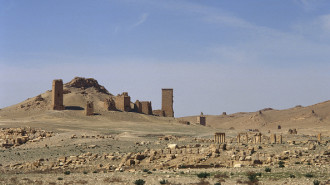Can, and would, the Houthis cut the Red Sea's undersea internet cables?
Yemen's Houthis could cut undersea cables, a report has claimed amid a spate of attacks on Red Sea shipping resulting in a confrontation with a US coalition and affecting prices of imported goods in many parts of the word.
The report, published by Gulf International Forum, details how undersea cables in the Red Sea could be severed by Houthi divers as part of an expansion of its military action in the Red Sea.
It comes after an allegedly Houthi-linked Telegram Channel posted an image of international cables that run through the Bab al-Mandeb strait with an implied threat.
"There are maps of international cables connecting all regions of the world through the sea. It seems that Yemen is in a strategic location, as internet lines that connect entire continents - not only countries - pass near it," the message said.
The question now is could the Houthis pull-off such a stunt, which would cripple international communication, and more importantly, would they want to?
What are the undersea cables that run through the Red Sea?
Starting out as telegraph cables laid in 1858 by the Atlantic Telegraph Company, undersea links, such as these, have become critical to international communication infrastructure for the global economy.
There are roughly 300 fibreoptic cables laid across the ocean floor allowing everything from financial transactions and phone calls, to military and diplomatic transmissions to be communicated worldwide - as well as a primary part of connecting the world to the internet.
These communications make up over 90 percent of the world's total communications, and also enable trillions of dollars worth of financial transactions every day.
According to Alan Mauldin, Research Director at telecommunications consultancy TeleGeography, many countries in Asia, East Africa, and the Middle East rely on these to connect with Europe.
Over half of these countries' interregional bandwidth is connected to Europe via the Red Sea, and over 90 percent of Europe-Asia capacity is carried by said cables, meaning the Red Sea is a main artery for data transmission between Europe, Africa and Asia.
According to their data, over 50 percent of India's interregional bandwidth runs through the Red Sea. This rises to nearly 60 percent for Qatar, over 70 percent for Oman, under 80 percent for the UAE, and 90 percent for Kenya.
Such cables that run through the route include FLAG Europe-Asia, a 28,000-kilometer cable running from Japan to the UK owned by Global Cloud Xchange, and SeaMeWe-6, a 21,700 km cable owned in part by Bahrain's Batelco, China Unicom, and Microsoft among others.
Both cables have landing points across the Middle East, South and East Asia, and Europe and are examples of the vast network that runs through the narrow strait.
Do the Houthis have the ability to conduct such a strike?
The Houthis have been waging a campaign against shipping in the Red Sea since October following the start of Israel's war on Gaza, which has killed 27,708 Palestinians according to Gaza's health authorities.
This includes striking a multitude of commercial ships allegedly destined for Israel, using its vast arsenal of ballistic missiles and drones to conduct said attacks, which has prompted US and UK retaliatory strikes since January.
According to Ahmed Nagi, a senior analyst on Yemen at the International Crisis Group, the Houthis have yet to make any official direct threat against undersea cables.
On 26 December, a statement issued from the Houthi-controlled Ministry of Telecommunications and Information Technology denied any threats against underwater cables running through the Bab al-Mandeb strait.
Despite, this Nagi said there is still the possibility that undersea cables could be targeted by the Houthis if the current confrontation in the Red Sea persists, especially as the rebels may not need advanced technology to achieve such an aim.
"First, the Houthis control a significant maritime space near the cable locations, and second, they can utilize explosive devices for this purpose, considering the group possesses naval mines that could be employed in such attacks."
However, given the global importance of the undersea cables to global communication infrastructure, such an attack would likely further widen the conflict against the Houthis.
"Given that the Red Sea underwater region houses numerous fiber cables providing internet services to several countries, severing these cables could result in partial or complete disruptions of internet services for many nations. This could potentially escalate the conflict and draw more countries into the fight against the Houthis," he added.




 Follow the Middle East's top stories in English at The New Arab on Google News
Follow the Middle East's top stories in English at The New Arab on Google News


![A group of Palestinians, foreign and Israeli activists gather to participated in an olive picking event on the land in the town of Battir, which is under threat of confiscation by Israel in Bethlehem, occupied West Bank on 8 November 2024. [Getty]](/sites/default/files/styles/image_330x185/public/2182930803.jpeg?h=199d8c1f&itok=__0LgGsa)